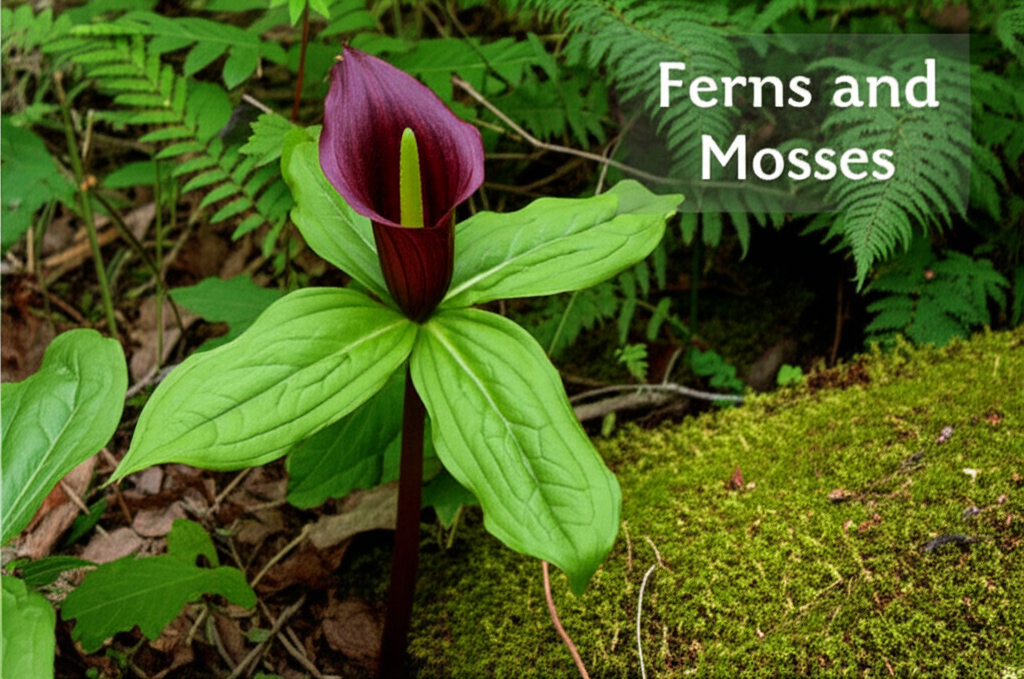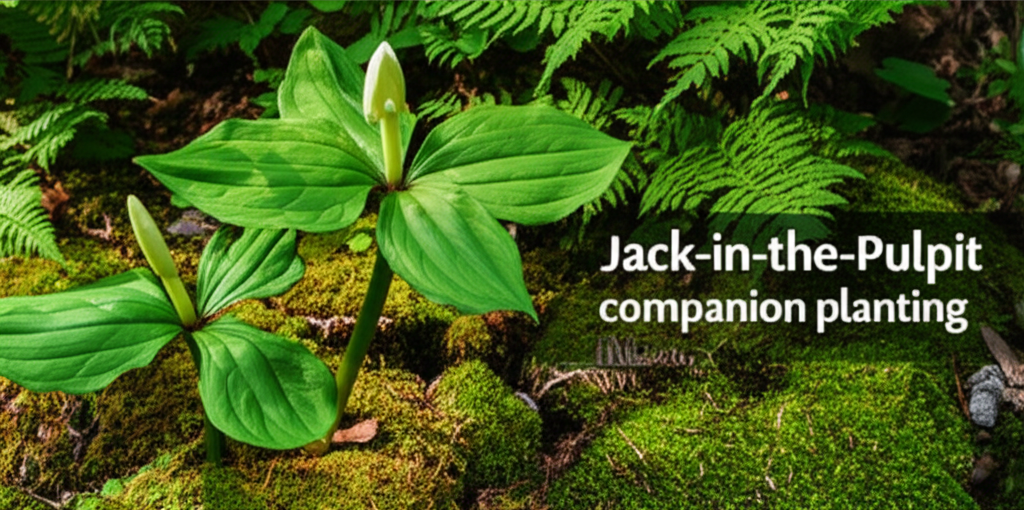Introduction to Jack-in-the-Pulpit and Its Ideal Habitat
Jack-in-the-Pulpit (Arisaema triphyllum) is a fascinating native woodland perennial renowned for its unique flower structure, resembling a pulpit with a hooded spathe covering the spadix. This captivating plant thrives in specific environmental conditions, mirroring those found in its natural forest floor habitat. Understanding these requirements is crucial for successful cultivation and, more importantly, for fostering a symbiotic relationship with its fellow woodland dwellers.
The ideal habitat for Jack-in-the-Pulpit is characterized by:
- Shade or Partial Shade: These plants prefer the dappled light filtering through a mature tree canopy. Direct, intense sunlight can scorch their leaves.
- Moist, Well-Drained Soil: Rich, humusy soil that retains moisture but doesn’t become waterlogged is essential. The soil should be slightly acidic to neutral in pH.
- High Humidity: Mimicking the humid atmosphere of a forest understory promotes healthy growth and prevents desiccation.
- Protection from Wind: Strong winds can damage their delicate foliage and developing flower structures.
When these conditions are met, Jack-in-the-Pulpit not only flourishes but also becomes a focal point in any shaded garden design. However, its true potential is unlocked when integrated into a thoughtfully designed planting scheme, where companion plants can enhance its growth, health, and aesthetic appeal. This is where the strategic use of companion planting with ferns and mosses comes into play.
The Symbiotic Relationship: Why Ferns and Mosses are Ideal Companions

Ferns and mosses are not merely ornamental additions to a Jack-in-the-Pulpit garden; they are integral components of a miniature ecosystem that mutually benefits all parties involved. Their shared preference for cool, moist, and shaded conditions makes them natural allies.
Ferns, with their intricate fronds and varied textures, offer several advantages when planted alongside Jack-in-the-Pulpit:
- Moisture Retention: The dense foliage of many fern species helps to shade the soil, reducing evaporation and maintaining consistent moisture levels, which is vital for Jack-in-the-Pulpit’s root system.
- Nutrient Cycling: As ferns decompose, they contribute organic matter to the soil, enriching it and providing a steady supply of nutrients.
- Pest Deterrence: Certain fern species may also deter common garden pests through their natural compounds or by providing habitat for beneficial insects.
- Aesthetic Harmony: The classic woodland aesthetic is incomplete without the graceful presence of ferns. Their diverse forms complement the unique architecture of the Jack-in-the-Pulpit.
Mosses, often overlooked but incredibly important, contribute significantly to the health and beauty of the microclimate:
- Soil Stabilization: Mosses form a living carpet that helps to prevent soil erosion, especially on slopes or in areas prone to disturbance.
- Moisture Buffering: They act like tiny sponges, absorbing excess water during wet periods and releasing it slowly during drier spells, thus moderating soil moisture.
- pH Regulation: While some mosses prefer acidic conditions, their presence can indicate and help maintain a suitable pH for woodland plants.
- Microhabitat Creation: The dense mat of moss provides a cool, humid microhabitat for small invertebrates and fungi, contributing to soil biodiversity.
- Visual Appeal: The lush, velvety texture of moss adds another layer of natural beauty, enhancing the serene woodland feel.
By understanding these interconnected benefits, gardeners can move beyond simply placing plants next to each other and instead focus on creating a cohesive, thriving woodland environment.
Key Facts and Comparison: Jack-in-the-Pulpit, Ferns, and Mosses
To better illustrate the compatibility and complementary nature of these woodland plants, let’s examine their key characteristics and how they align.
| Feature | Jack-in-the-Pulpit (Arisaema triphyllum) | Ferns (General Characteristics) | Mosses (General Characteristics) |
|---|---|---|---|
| Light Requirements | Shade to partial shade | Shade to partial shade (varies by species) | Shade to partial shade |
| Soil Moisture | Consistently moist, well-drained | Moist to damp, well-drained | Moist to wet, often prefers consistent moisture |
| Soil Type | Rich, humusy, slightly acidic to neutral | Humus-rich, well-drained (varies by species) | Adaptable, often thrives in organic matter |
| Humidity Needs | High | Moderate to high | High |
| Root System | Rhizomatous, spreads underground | Fibrous, shallow to moderate depth | Rhizoids (anchoring structures, not true roots) |
| Aesthetic Contribution | Unique, architectural flower; attractive trifoliate leaves | Varied textures, delicate to robust fronds; adds depth and movement | Lush groundcover; soft texture; enhances natural look |
| Ecological Role | Food source for wildlife (berries), habitat | Habitat for insects and small animals; contributes organic matter | Soil stabilization, moisture buffering, habitat for microfauna |
This table highlights the significant overlap in preferences, making them natural companions. While Jack-in-the-Pulpit has a more distinctive and singular visual appeal, ferns and mosses provide a supportive and grounding backdrop, creating a complete woodland tableau.
Selecting the Right Ferns and Mosses for Your Jack-in-the-Pulpit Garden
Choosing the appropriate fern and moss species is crucial for creating a balanced and thriving ecosystem. Consider your specific site conditions, including soil type, light levels, and moisture availability, when making your selections.
Recommended Fern Species for Companion Planting:
- Ostrich Fern (Matteuccia struthiopteris): Known for its tall, vase-shaped habit, Ostrich Fern thrives in moist to wet soil and partial shade. Its broad fronds provide excellent ground cover and help retain moisture.
- Lady Fern (Athyrium filix-femina): This delicate, graceful fern prefers moist, humus-rich soil and partial to full shade. It has a lovely, feathery texture that complements the bolder foliage of Jack-in-the-Pulpit.
- Maidenhair Fern (Adiantum pedatum): With its distinctive fan-shaped fronds and black stems, Maidenhair Fern adds an elegant touch. It prefers moist, acidic soil and shaded locations.
- Christmas Fern (Polystichum acrostichoides): A more robust and adaptable fern, Christmas Fern tolerates drier conditions once established and can even handle some sun. Its evergreen fronds provide winter interest.
- Cinnamon Fern (Osmundastrum cinnamomeum): This striking fern features fertile fronds that turn cinnamon-brown. It thrives in wet, boggy conditions and full to partial shade.
Recommended Mosses for Groundcover:
- Sheet Moss (Hypnum cupressiforme): A common and versatile moss that forms dense, carpet-like mats. It prefers shade and consistent moisture and is excellent for covering bare soil.
- Fern Moss (Thuidium delicatulum): Resembling tiny ferns, this moss adds a delicate, feathery texture to the ground. It thrives in shady, moist environments.
- Hair Cap Moss (Polytrichum commune): A taller moss that can form dense tufts. It’s quite tolerant of varying moisture levels and can be found in shaded, damp areas.
- Mood Moss (Dicranum scoparium): Known for its “moody” appearance, this moss forms soft cushions and prefers shaded, moist locations.
When selecting mosses, aim for species that are native to your region and suited to the microclimate you are creating. Observe where moss naturally grows in local woodlands for inspiration.
Steps to Establishing a Thriving Companion Planting Ecosystem
Creating a successful companion planting scheme with Jack-in-the-Pulpit, ferns, and mosses involves careful planning and execution. Follow these steps to establish a beautiful and sustainable woodland garden.
| Step | Description | Key Considerations |
|---|---|---|
| 1. Site Selection and Preparation | Choose a location that receives dappled shade or partial shade throughout the day. The soil should be rich in organic matter and consistently moist but well-drained. Amend the soil with compost or leaf mold to improve its structure and fertility. | Avoid areas with full sun or waterlogged conditions. Test soil pH if necessary (aim for slightly acidic to neutral). |
| 2. Planting Layout and Spacing | When planting Jack-in-the-Pulpit, position them where their unique form will be visible. Group them naturally, allowing space for their rhizomatous spread. Plant ferns around and between the Jack-in-the-Pulpit, considering their mature size and spread. Moss can be introduced as a groundcover, either by placing sods or by encouraging natural colonization. | Consider mature plant sizes to avoid overcrowding. Place taller ferns towards the back or sides to create depth. |
| 3. Initial Watering and Mulching | Water all newly planted specimens thoroughly. Apply a layer of organic mulch (such as shredded bark, leaf mold, or pine needles) around the plants, keeping it a few inches away from the base of the stems. Mulch helps retain moisture, suppress weeds, and regulate soil temperature. | Ensure mulch does not directly contact plant stems to prevent rot. |
| 4. Ongoing Care and Maintenance | Water regularly, especially during dry periods, to keep the soil consistently moist. Fertilize sparingly with an organic fertilizer in spring if needed. Monitor for pests and diseases, though healthy companion plantings are generally more resilient. Remove any invasive weeds promptly. | Avoid over-fertilizing, which can lead to leggy growth. Observe plants for signs of stress (wilting, yellowing leaves). |
| 5. Encouraging Moss Growth | If introducing mosses from sod, gently press them into the prepared soil. Keep the area consistently moist until the moss is established. In areas where moss is sparse, you can try a “moss milkshake” – blending moss with buttermilk or yogurt and water, then painting it onto suitable surfaces. | Patience is key; moss establishment can take time. Ensure shade and consistent moisture. |
Pros and Cons of Companion Planting with Ferns and Mosses:
| Pros | Cons |
|---|---|
| Enhanced moisture retention: Ferns and mosses help keep the soil consistently moist, crucial for Jack-in-the-Pulpit. | Potential for overcrowding: If plants are not spaced correctly, they can compete for resources. |
| Improved soil health: Decomposition of organic matter from companion plants enriches the soil. | Increased susceptibility to slugs and snails: The moist, shaded environment can attract these pests. |
| Natural aesthetic: Creates a lush, cohesive woodland garden look. | Requires consistent moisture: Not suitable for dry or arid conditions. |
| Reduced weed competition: Dense foliage and moss cover suppress weed growth. | Slower establishment for moss: Mosses can take time to fully establish and spread. |
| Habitat for beneficial insects: Provides shelter and food for a variety of small creatures. | Specific light and soil needs: Requires careful site selection to match the plants’ requirements. |
| Pest deterrence: Some companion plants may naturally deter pests. | Potential for disease: Overly wet conditions can lead to fungal issues if drainage is poor. |
Long-Term Benefits and Creating a Self-Sustaining Woodland Garden
The true beauty of companion planting Jack-in-the-Pulpit with ferns and mosses lies in its ability to create a self-sustaining ecosystem. Over time, the plants will naturalize, and the garden will require less intervention.
The benefits extend beyond aesthetics:
- Increased Biodiversity: The combination of plants provides varied microhabitats, attracting a wider range of insects, birds, and other small wildlife, contributing to a healthier local ecosystem.
- Improved Soil Structure: The constant addition of organic matter from decomposing plant material improves soil aeration and drainage, making it more hospitable for plant roots.
- Natural Pest and Disease Control: A diverse planting reduces the likelihood of a single pest or disease decimating the garden. Beneficial insects that inhabit the area will help keep pest populations in check.
- Reduced Maintenance: Once established, a well-balanced companion planting will largely take care of itself, requiring only minimal pruning and occasional watering during extreme drought.
- Year-Round Interest: The varying textures and forms of Jack-in-the-Pulpit, ferns, and mosses provide visual appeal throughout the seasons, from the emergence of spring ephemerals to the evergreen foliage of some ferns and the subtle textures of moss in winter.
Creating a self-sustaining woodland garden is a rewarding endeavor. It’s about working with nature rather than against it, fostering a miniature world where plants thrive in harmony, each contributing to the overall health and resilience of the environment. The unique charm of the Jack-in-the-Pulpit, amplified by the serene beauty of ferns and the verdant carpet of moss, offers a truly captivating and ecologically sound garden experience.


